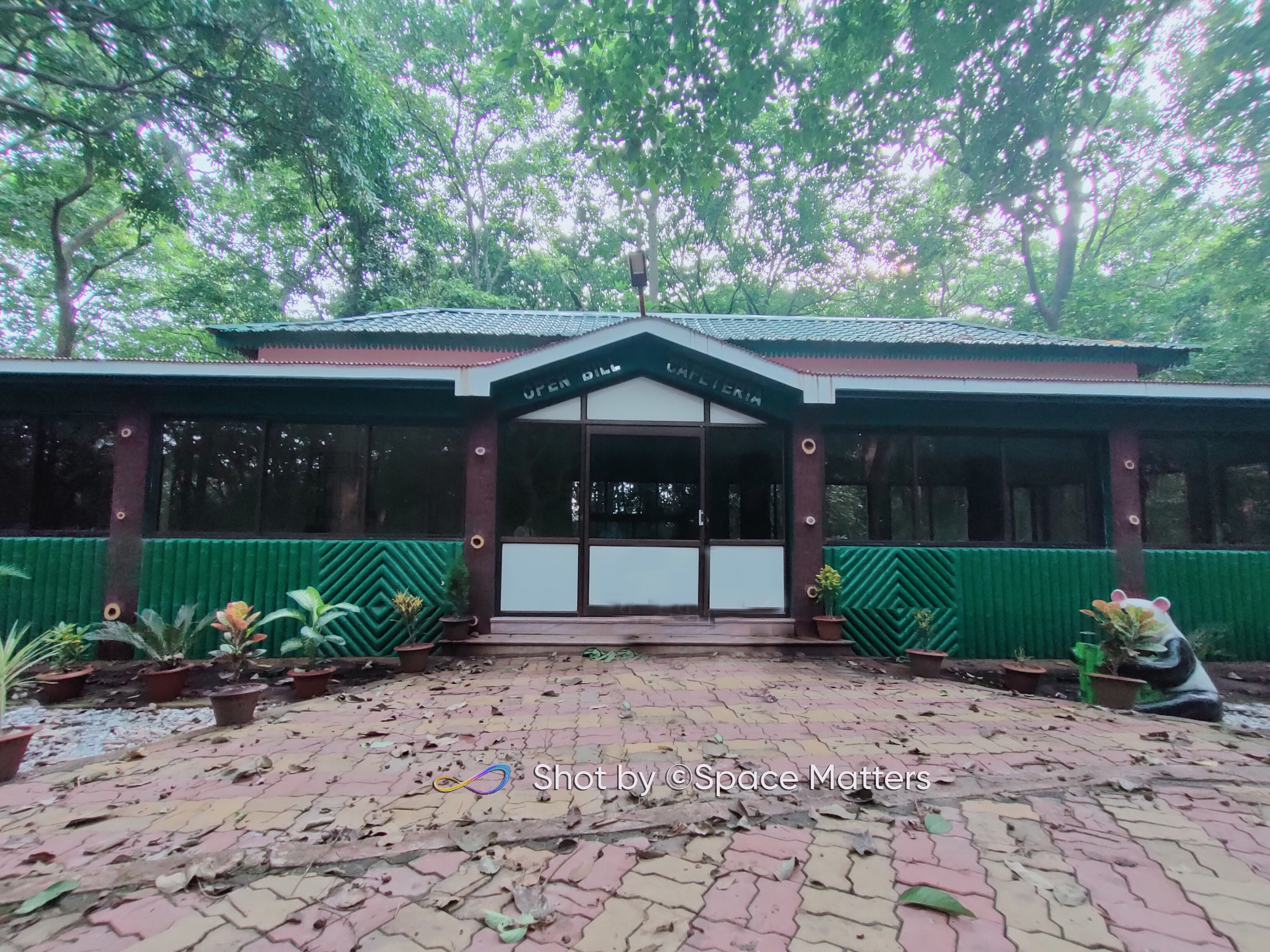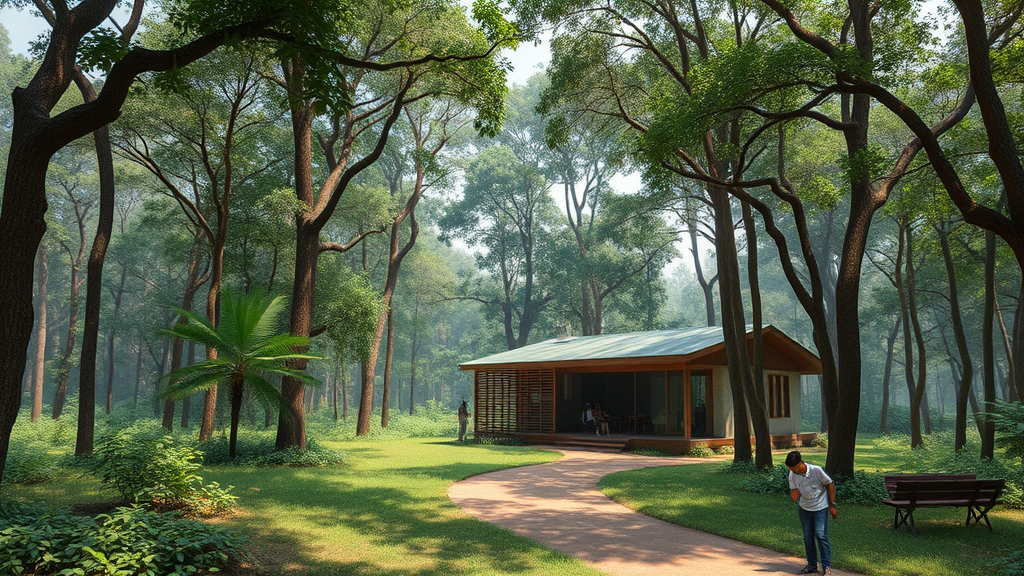🌿 Exploring Kulik Wildlife Sanctuary: An Architect’s Perspective on Harmonizing Nature and Design
Introduction
Nestled near Raiganj in Uttar Dinajpur District of West Bengal, Kulik Wildlife Sanctuary is more than just a haven for birdwatchers—it's a testament to how architecture and nature can coexist harmoniously.
As an architect, visiting this sanctuary was not just a visual delight but also an insightful experience into sustainable design principles inspired by nature. 🍃
🗺️ Site Plan Analysis of Kulik Bird Sanctuary
📍 Zoning and Spatial Layout
- Core Habitat Zone: The central area, surrounded by dense tree cover and water bodies, serves as the primary nesting site for migratory birds. This strategic zoning minimizes human interference, ensuring a safe breeding environment.
- Visitor Movement Pathways: The sanctuary has a network of metalled and unmetalled pathways, allowing visitors to explore without disturbing the wildlife. The strategic alignment of these paths ensures optimal viewing experiences from a safe distance.
- Watch Towers and Viewing Points: Multiple watch towers are strategically positioned around the water bodies, providing panoramic views of the bird colonies. These elevated structures minimize human impact while maximizing bird-watching opportunities.
🌊 Water Bodies and Ecological Importance
- The sanctuary is bordered by the Kulik River, which supports perennial and non-perennial canals. These water bodies are crucial for maintaining the wetland ecosystem, attracting a diverse range of migratory birds. The layout of water channels supports feeding and nesting activities of Migratory Birds
🏞️ Landscape and Vegetation
- Tree Cover: Dense vegetation provides shade, nesting sites, and a natural habitat for birds, ensuring ecological balance.
- Garden Areas: These landscaped zones enhance visitor experience without compromising the sanctuary’s natural aesthetics.
🚧 Infrastructure and Visitor Facilities
- Community Centre and Toilets: Conveniently located near the entrance for visitor comfort.
- Animal Rescue Centre: Positioned strategically for quick access and wildlife management.
- Forest Bungalow: Offers accommodation for researchers and nature enthusiasts, promoting eco-tourism.
🛤️ Accessibility and Connectivity
- The sanctuary is accessible via NH-34, ensuring smooth connectivity to Raiganj Town & from Dalkhola other side. The layout is designed to guide visitors seamlessly from the entrance to various viewing points while maintaining a clear separation from the core habitat zone.
🦜 Avian Visitors at Kulik Wildlife Sanctuary: A Migratory Marvel
One of the most captivating aspects of Kulik Wildlife Sanctuary is its role as a temporary home for thousands of migratory birds. Every year, this sanctuary witnesses an extraordinary spectacle as flocks of Asian Openbill Storks, Egrets, Cormorants, and other migratory species arrive, transforming the lush greenery into a bustling avian metropolis.
🗓️ Arrival and Departure Timings
The migratory season at Kulik Wildlife Sanctuary typically begins in June, with the arrival of Asian Openbill Storks, followed by other species such as egrets and cormorants. These migratory birds come from far-off regions, primarily from South-East Asia and Eastern Europe, seeking favorable nesting conditions and abundant food supply.
- 🚀 Arrival Time: June to July – The early monsoon showers create a thriving ecosystem with ample food, attracting the first wave of migratory birds.
- 🏡 Nesting Period: July to September – During this period, the sanctuary is alive with activity as birds build nests, hatch eggs, and nurture their young ones.
- ✈️ Departure Time: November to December – As winter approaches, the fully grown juveniles and adult birds begin their long journey back to their native lands.
📊 Bird Population Statistics
Kulik Wildlife Sanctuary is known to host an impressive population of migratory birds every year:
- 🐦 Asian Openbill Storks: The most prominent visitors, with populations often exceeding 70,000 during peak season.
- 🕊️ Egrets and Cormorants: These species contribute to a total migratory bird count of around 1,00,000 annually.
- 🌍 Biodiversity: In total, more than 50 species of migratory birds are recorded at the sanctuary, making it one of the largest bird colonies in Asia.
🔍 Ecological Significance and Architectural Inspiration
As an architect, observing this grand avian spectacle offers unique insights into the delicate balance of ecosystems. The harmonious cohabitation of diverse bird species amidst dense foliage and water bodies demonstrates the importance of designing spaces that respect and preserve natural habitats. 🌏
The seasonal influx of birds and their nesting patterns also highlight the role of temporal architecture—designing structures that adapt to changing environmental conditions. This principle resonates with the philosophy of sustainable architecture, where buildings coexist with natural cycles, minimizing ecological disruption.
🌳 A Symphony of Natural Design
Kulik Wildlife Sanctuary is renowned for its thriving population of Asian Openbill Storks, among other migratory birds. The sanctuary's design is inherently organic, with meandering pathways, rustic bridges, and viewing platforms strategically placed to provide immersive, undisturbed experiences of the natural habitat.
The architectural elements blend seamlessly with the lush greenery, demonstrating how built spaces can complement, rather than compete with, the environment. 🏞️
🏛️ Architecture in Harmony with Nature
The sanctuary’s entrance is a beautiful example of contextual design, featuring wooden beams and earthy tones that blend with the forest backdrop. This thoughtful use of locally sourced materials minimizes environmental impact while creating a welcoming gateway that resonates with the sanctuary’s natural essence. 🌲
Key Architectural Observations:
- 🌉 Rustic Pathways and Bridges: The winding trails and bridges are constructed using natural stone and wood, ensuring minimal disruption to the ecosystem. These pathways guide visitors through the dense foliage, enhancing the sensory experience of walking amidst nature.
- 🌄 Elevated Viewing Platforms: Strategically placed to offer panoramic views of bird colonies without disturbing their habitat, these platforms showcase how sensitive site planning can create impactful user experiences.
- 🏕️ Minimalist Structures: Resting areas and information kiosks are designed with simplicity, using locally sourced materials that blend with the natural surroundings, minimizing visual clutter.
♻️ Lessons in Sustainable Architecture
Kulik Wildlife Sanctuary is a living example of how sustainable architecture can be achieved by observing and respecting natural systems. As architects, we can learn the following principles:
- 🌏 Contextual Design: Buildings should respond to the natural environment rather than imposing on it.
- 🔄 Minimal Intervention: Design elements should aim for minimal disruption to the existing ecosystem.
- 🧱 Material Selection: Locally sourced, sustainable materials reduce carbon footprint and enhance contextual aesthetics.
🌠 Conclusion: A Sanctuary of Design Wisdom
Kulik Wildlife Sanctuary isn’t just a refuge for birds—it’s a sanctuary of design wisdom. For architects, it serves as a powerful reminder of the potential to create spaces that honor and enhance natural ecosystems. As we move towards a more sustainable future, Kulik stands as a beacon of inspiration, guiding us to design with nature, not against it. 🌞
🧭 Visit and Experience
If you’re an architect, designer, or nature enthusiast, Kulik Wildlife Sanctuary is a must-visit for first-hand experience of how architecture and nature can coalesce beautifully. It’s a journey of inspiration that leaves you with a deeper appreciation for sustainable, context-sensitive design. 🕊️
🧭 Plan Your Visit
Visiting during the peak migratory season (July to October) offers a breathtaking view of thousands of birds nesting and feeding in their natural habitat. It’s a remarkable experience for architects, bird enthusiasts, and nature lovers alike. 🕊️
🌐 Architectural Insights and Recommendations
From an architectural perspective, the layout is well-thought-out, balancing ecological conservation with tourism. However, to enhance the visitor experience while maintaining ecological sensitivity:
Here’s a conceptual approach to designing a Nature Interpretation Center near Kulik Wildlife Sanctuary:
1. Design Concept:
Theme:
- Inspired by the riverine ecosystem of Kulik and its biodiversity, especially the migratory bird population.
- Focus on sustainable architecture, blending with the natural surroundings.
2. Key Zones and Features:
Entrance Pavilion:
- Reception and ticketing counter.
- Visitor information boards with maps and wildlife details.
Exhibition Hall:
- Displays about flora, fauna, and bird species in the sanctuary.
- Interactive kiosks, dioramas, and audio-visual presentations.
Observation Decks:
- Elevated viewpoints to observe the bird nesting colonies.
- Telescopes and binocular facilities.
Nature Trails and Boardwalks:
- Elevated wooden pathways for exploration without disturbing the ecosystem.
- Interpretive signage about local ecology.
Auditorium and Workshop Spaces:
- For educational programs, talks, and film screenings.
- Workshops for eco-crafts and birdwatching techniques.
Library and Resource Center:
- A collection of books, journals, and research papers on biodiversity.
- Digital access to documentaries and research archives.
Cafeteria and Souvenir Shop:
- Eco-friendly souvenirs related to wildlife.
- Local cuisine to promote regional culture.
Accommodation (Optional):
- Eco-lodges or tents for overnight visitors.
- Focus on sustainable materials and solar-powered utilities.
3. Sustainable Design Features:
Material Palette:
Bamboo, mud plaster, exposed bricks, and stone cladding to blend with nature.Green Roofs and Walls:
To improve insulation and visual harmony with surroundings.Rainwater Harvesting:
Collect and reuse rainwater for irrigation and utilities.Solar Energy Panels:
Minimize dependence on external power grids.Wastewater Treatment System:
Bio-filtration systems for water recycling.
4. Architectural Style Suggestions:
- Organic forms resembling bird nests or rippling water patterns.
- Vernacular techniques fused with modern design principles.
- Open, airy spaces with large overhangs to reduce heat gain.
Design
Inspired by Vernacular / Local Architecture , the Locally available material like bamboo, bamboo sticks, Stone, Wood Earth, Grass, Bengal Pure Rice Whole Uncut Bundle of Straws heys in Uttar Dinajpur . Also inspired by the traditional huts in a villages of West Bengal. These huts being made of locally available materials like mud, twigs. Mud huts and hay stacks are some of the common images of rural India. Though these designs appear amateur they withstand the test of time and are ideal for the tropical climate of India.
- Floating Pathways could be introduced over non-perennial canals for immersive bird-watching experiences.
- Sustainable Viewing Decks integrated with natural materials would minimize visual impact. Also there must be a platform where humans can interact interpret and observe deep with Wetlands flora & fauna
- Interactive Interpretation Centers can be designed near the entrance to educate visitors about the migratory birds and the sanctuary’s biodiversity.
This strategic blend of sustainable design and eco-tourism principles can enhance the sanctuary’s role as a major bird-watching destination while preserving its ecological sanctity. Would you like to explore more architectural interventions or sustainable design ideas for this site? 😊
At Space Enhance Architects, we are continually inspired by the symbiotic relationship between architecture and nature, as beautifully exemplified by Kulik Wildlife Sanctuary. Visit our website at www.enhancespace.in to explore how we translate these inspirations into sustainable architectural solutions. 🌐
© 2025 Enhance Space Architects | All Rights Reserved























.png)

.png)

.jpg)
.jpg)
.png)

Comments
Post a Comment